GO TO-U: EV Charging Speed - What Affects It
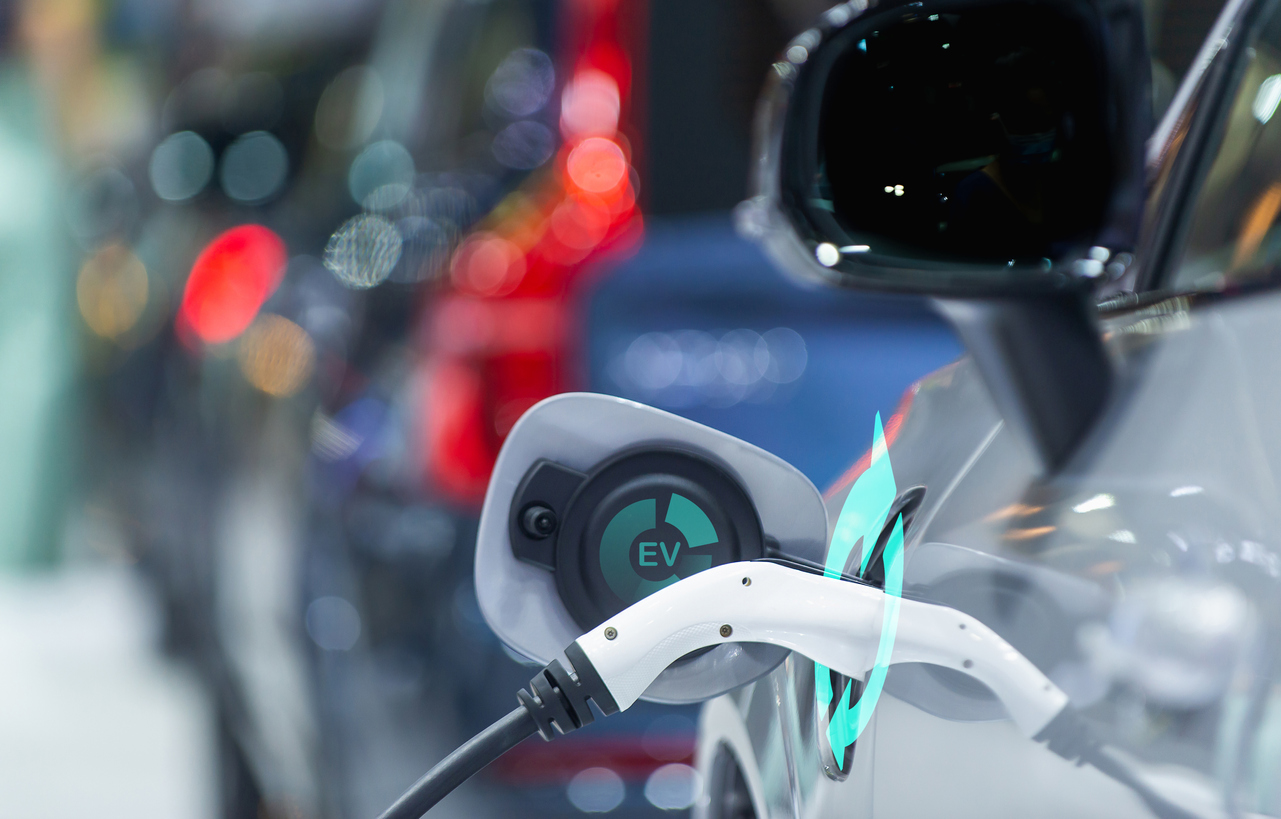
As the shift towards sustainable transportation accelerates, electric vehicles (EVs) have become an integral part of the automotive landscape. For current and prospective EV owners, understanding the nuances of EV charging speed is critical. This article is crafted for EV enthusiasts, potential buyers, and environmental advocates who seek to comprehend the factors that influence the time it takes to power up their vehicles. With the adoption of electric cars on the rise, the ability to efficiently charge an EV is not just a convenience; it's a necessity that affects daily use and long-term satisfaction with an electric vehicle.
One of the most common questions posed by EV users is "what determines charging speed?" The answer to this question is multifaceted, as several variables come into play, each contributing to the overall time it takes to charge an EV. In this article, we'll delve into the key factors that affect EV charging speed, providing insights supported by recent data and research.
Here are 5 key factors that affect the charging speed of an electric car.
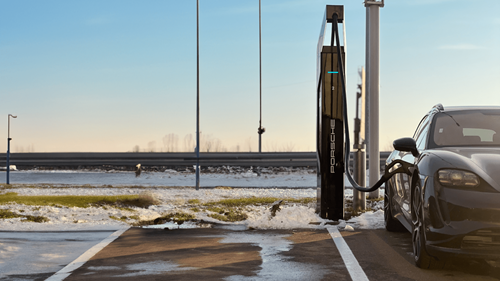
Battery Capacity and Health
The larger the battery capacity, i.e., its volume, the more time is needed for battery charging speed. For example, if a Nissan Leaf with a 40 kilowatt-hour battery charges at a 50-kilowatt DC station in about 1.5 hours, then a GMC Hummer EV with a battery over 200 kWh will require about 4.5 hours.
This also concerns battery degradation when it loses its properties. Typically, this process manifests in a reduction of usable capacity and can also reduce the peak charging capability. For example, if initially a car could charge at a speed of 170 kW, then after 5 years it will accept a maximum of 160 kW due to changes in the chemical processes in the battery cells.
Battery State Before Charging
Another aspect that influences ev charging speed is the battery's state of charge before being plugged in. It's a common misconception that a battery with 50% charge will fill up twice as fast as one that's completely empty. In reality, the fastest charging speeds are usually attained when the battery is between 20% to 80% of its total capacity. Beyond 80%, the charging rate typically slows down to protect the battery's longevity. Therefore, if the goal is to fully charge the battery, the process will take considerably longer.
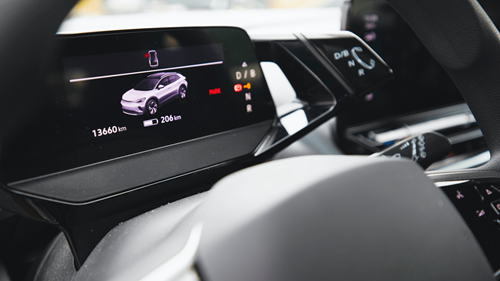
Maximum Charging Speed of the Vehicle
The EV itself has a maximum charging speed, which acts as a ceiling for how fast the battery can be charged. This is an inherent limitation based on the vehicle's design and the specifications of its onboard charging system.For example, the 2023 Audi e-tron is capable of receiving up to 270 kW from a charging station, even if the station's output is 350 kW. However, this is not a continuous rate as it represents the vehicle's peak charging speed.
Charging Station Power and Availability
The charging station's power also dictates the ev charging speed. Home chargers are significantly less powerful compared to rapid charging stations, which can offer 50 kW, 150 kW, or more. The maximum speed of the charging station sets the upper limit for how quickly an EV can be charged.
Moreover, the availability of power at public stations can vary, especially when multiple vehicles are charging simultaneously. A 120-kilowatt station designed for two cars will provide 120 kW to a single connected car but will split the power between two vehicles if both are charging at the same time. This division of power can lead to fluctuations in the charging speed experienced by each car.
Weather Conditions and Their Impact
Weather plays a critical role in affecting the battery charging speed. Batteries and charging stations operate less efficiently in colder temperatures, which can have a significant effect on charging times. For instance, at +25 degrees Celsius, charging conditions are optimal, while at +10 degrees Celsius, the process slows slightly as the batteries require time to reach an optimal temperature. At 0 degrees Celsius, charging becomes notably slower, and at temperatures of -5 degrees Celsius or lower, the chemical reactions within the battery are significantly limited, further reducing the charging speed. This is particularly true for older batteries, which may be more sensitive to temperature conditions.
In the next sections, we will explore the real-world implications of these factors, including visual data representations and case studies that further illustrate the variability of EV charging speeds. Continuing our exploration into the factors that influence the EV charging speed, let's delve into real-world scenarios that elucidate the complexities of charging an electric vehicle.
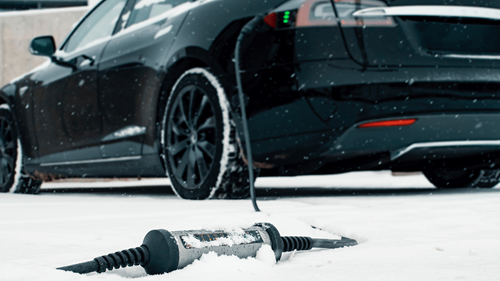
Visualizing the Data: A Closer Look at EV Charging Speed
To better understand how these variables interact in the real world, let's consider a visual representation of EV charging under different conditions.
Table: Comparison of Charging Speeds at Different Temperatures
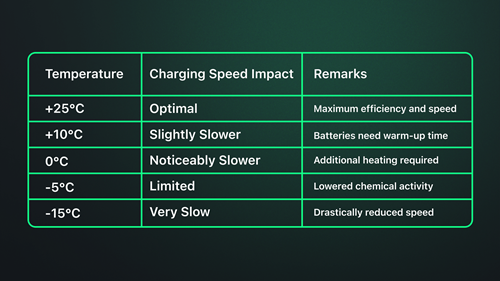
This table offers a snapshot of how temperature can affect the charging process, which is particularly relevant given the increasing interest in EVs in regions with cold climates.
Bullet Points: Key Takeaways on How Weather Affects Charging Speed
- Charging is most efficient at moderate to warm temperatures (+25°C).
- Colder climates necessitate additional time for the battery to reach an optimal charging temperature.
- Extreme cold can dramatically decrease the ev charging speed, necessitating strategic planning for EV users in these environments.
Real-World Charging: Insights and Variability
To provide a concrete example, consider the data from a charging session captured by the GO TO-U application. In this session, you can observe how the charging power offered by the station (shown in blue) and the power the car is able to accept or request (in green) fluctuate over time. Initially, another vehicle was charging in parallel, which meant the power was shared. Once the other vehicle completed its charge and disconnected, the full power became available to the single car. However, by that point, the car's battery had reached 80% charge, which resulted in a tapering off of the charging speed as the battery approached full capacity.
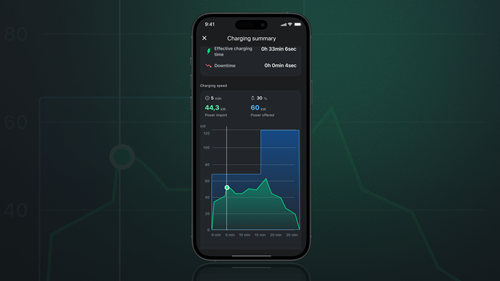
This real-life example underscores the dynamic nature of EV charging and highlights the importance of understanding the factors at play. It also demonstrates the need for robust battery management systems that can dynamically adjust to various conditions to optimize charging.
As electric vehicles continue to advance, industry efforts are focused on improving battery technology and charging infrastructure. Innovations such as battery preconditioning, where the vehicle prepares its battery temperature in anticipation of charging, are increasingly being implemented to minimize the effects of cold weather and maximize charging efficiency.
In conclusion, the ev charging speed is influenced by a complex interplay of factors, including battery capacity and health, the state of charge before plugging in, the vehicle's maximum charging capacity, charging station power, and environmental conditions. Understanding these variables can help EV owners make informed decisions about when and where to charge their vehicles, as well as manage expectations around the time required to do so.
As the electric vehicle market continues to grow, the industry is working tirelessly to enhance charging technology, providing faster, more convenient charging solutions. For EV owners, this means a future where charging becomes as quick and straightforward as refueling a conventional gasoline vehicle. Until then, knowledge of what determines charging speed remains an essential aspect of the EV experience, empowering users to navigate the evolving landscape of electric mobility with confidence.
The insights provided in this article highlight the multifaceted nature of EV charging, offering a clearer understanding of the factors that affect how quickly you can get back on the road. As you adapt to the nuances of electric vehicle ownership, keep these considerations in mind to ensure your EV charging experience is as efficient and hassle-free as possible.
About GO TO-U
.png) GO TO-U was founded in 2017 to accelerate transport decarbonization by making the experience of driving and charging electric vehicles simpler, more comfortable, and more accessible. At GO TO-U we put users at the center of GO TO-U software solutions for EV charging management and operations so we can create a seamless experience for both charge point operators and drivers.
GO TO-U was founded in 2017 to accelerate transport decarbonization by making the experience of driving and charging electric vehicles simpler, more comfortable, and more accessible. At GO TO-U we put users at the center of GO TO-U software solutions for EV charging management and operations so we can create a seamless experience for both charge point operators and drivers.






Comments
There are no comments yet for this item
Join the discussion